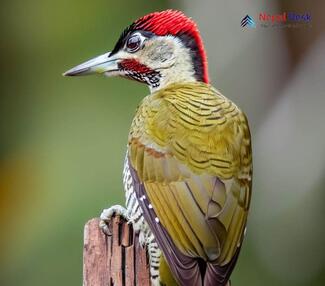Nestled among the diverse flora and fauna of Nepal, the Streak-throated Woodpecker (Picus xanthopygaeus) is a remarkable bird worth admiring. This fascinating species features striking plumage, an unmistakable call, and an endearing penchant for drumming away at tree trunks. In this article, we'll delve into all related details about this captivating creature and explore its presence in Nepal's rich ecosystem.
A Vibrant Appearance
The Streak-throated Woodpecker stands out with its distinct appearance. Its olive-green upperparts display a series of black streaks, while its crown possesses a brilliant red hue in males and a dark shade in females. The underparts are white with brownish bars, which gradually fade towards the ventral region. Adult woodpeckers reach lengths of 25-28 cm and have sharp, chisel-like beaks that serve them well in foraging for food.
Inimitable Call
The call of the Streak-throated Woodpecker is a characteristic "kweek-kweek-kweek" sound that becomes faster and louder over time. Its vocals are rich in tonal quality, carrying effortlessly through dense forests. The undeniable uniqueness of their vocalizations makes it easy for birdwatchers to identify them from afar.
Habitat and Diet
Streak-throated Woodpeckers can be found across South Asia, particularly in countries like India, Pakistan, Bangladesh, Bhutan, and Nepal. They prefer open deciduous forests, wooded areas along rivers, and even human-modified landscapes like orchards and gardens.
As for diet, this woodpecker is predominantly insectivorous. It forages insects under the bark of trees and on tree trunks, using its sharp beak to pry open crevices or drill holes. Common victims on the menu include ants, caterpillars, beetles, and larvae.
Presence in Nepal
Nepal provides an ideal habitat for the Streak-throated Woodpecker due to its mix of deciduous forests and lush green landscapes. They can be observed throughout various regions in Nepal, including the Terai lowlands, Shivapuri Nagarjun National Park, and Bardia National Park. The population of this species in Nepal is considered stable; however, habitat destruction may pose risks to their long-term well-being.
Capturing the Enchantment: Bird-Watching Tips
For those wishing to catch a glimpse of these magnificent creatures in their natural habitat, here are some tips:
- Visit prime locations at the right time: Early mornings tend to have increased bird activity. Knowing where these woodpeckers frequent gives you a higher chance of spotting them.
- Listen for their unique calls: Train your ears to recognize the distinctive "kweek-kweek-kweek" call of the Streak-throated Woodpecker.
- Exercise patience: Birdwatching demands patience – don't rush through a sighting and appreciate the marvels of nature as they unfold before you.
In conclusion, the Streak-throated Woodpecker (Picus xanthopygaeus) is a remarkable addition to Nepal's diverse wildlife. From its vibrant appearance to its presence across the country's lush landscapes, exploring all facets of this captivating creature is truly an unforgettable experience for nature enthusiasts and birdwatchers alike.




